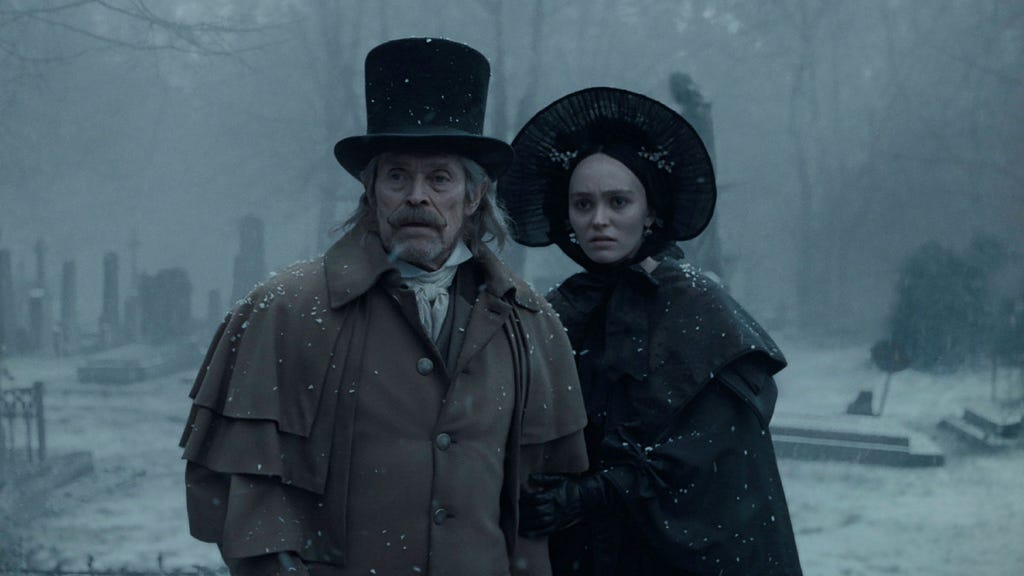Robert Eggers’ ”Nosferatu” (2024) is a haunting reimagining of F.W. Murnau’s 1922 silent film classic, itself an unauthorized adaptation of Bram Stoker’s ”Dracula.” Eggers, known for his blend of traditional mythology and innovative mysticism, centers his interpretation on the psychologically fragile newlywed Ellen Hutter, granting her agency and positioning her as both the instigator and ultimate recipient of the narrative’s horrors. Her whispered plea, ”Come to me…”, sets in motion a chain of events echoing through the familiar ”Dracula” storyline: a young lawyer journeys to a Transylvanian castle, encounters a sinister count, barely escapes with his life, and inadvertently unleashes a plague upon his unsuspecting hometown. However, Eggers’ approach breathes new life into this well-trodden territory. His film isn’t simply a rehash but a passionate engagement with a visually striking and enduring classic, skillfully adapted to resonate with contemporary audiences.
Eggers’ ”Nosferatu” stands apart from previous adaptations by embracing the burgeoning resurgence of romanticism. Visually, the film pays homage to Murnau’s original with its menacing shadows and sharp-clawed antagonist, borrowing elements of German Expressionism inspired by Caspar David Friedrich. However, Eggers infuses the familiar imagery with a distinct, dreamlike quality, particularly in the scenes depicting Thomas Hutter’s (Nicholas Hoult) journey to the dilapidated castle. These sequences possess a painterly, grayish-blue palette that is breathtakingly beautiful, even amidst the encroaching dread. Beyond the visual, the film delves into the philosophical core of romanticism. Ellen, in contrast to her more conventional friend Anna (Emma Corrin), is portrayed as an introverted rebel seeking solace in the irrational and subjective, a stark contrast to the patriarchal constraints of her time. This internal rebellion, reminiscent of the Romantic thinkers of the late 18th and early 19th centuries, sets the stage for her fateful encounter with the undead Count Orlok.
Lily-Rose Depp delivers a captivating performance as Ellen, embodying a chilling version of female liberation. Her portrayal is both vulnerable and powerful, capturing the character’s psychological and physical unraveling as she confronts the seductive horror of Count Orlok. This encounter, far from a traditional romance, is a perverse and unsettling exploration of lust, shame, and the conflicting appetites for life and death. Bill Skarsgård, unrecognizable under heavy prosthetics, embodies Nosferatu with both a repulsive decay and a strange magnetism. His performance, enhanced by impressive vocal work, evokes an ancient, otherworldly presence, far removed from the anti-Semitic caricatures of the past. Meanwhile, Willem Dafoe steals scenes as the eccentric occultist von Franz, offering a glimmer of light and much-needed levity amidst the pervasive darkness. His character, attuned to the supernatural, provides a fascinating counterpoint to the more grounded characters, injecting a touch of the uncanny into the narrative.
Eggers, a long-time admirer of Murnau’s work and German Expressionism, brings his fascination with folklore, cults, witchcraft, and demonic forces to bear on this reimagining. His previous films, ”The Witch” and ”The Lighthouse,” established his mastery of atmospheric horror, while ”The Northman,” though a departure stylistically, showcases his comfort with grotesque imagery. In ”Nosferatu,” Eggers returns to his earlier form, delivering a film that is both deeply unsettling and profoundly ambivalent. As befits a story born from a dark and pestilential era, the film exudes a sense of gruesome, decaying romanticism, further amplified by Eggers’ masterful direction. This ”Nosferatu” is not merely a horror film; it is a work of art that terrifies and seduces with moonlit brilliance.
Eggers’s film isn’t merely a tribute to Murnau; it’s a distinct and powerful reinterpretation of the classic vampire narrative. By focusing on Ellen’s perspective and imbuing her with a sense of agency, Eggers subverts the traditional damsel-in-distress trope and explores the complexities of female desire in the face of unimaginable horror. The film’s romantic elements aren’t simply aesthetic flourishes; they represent a deeper philosophical exploration of the human condition, the allure of the unknown, and the seductive power of darkness. The clash between Ellen’s yearning for something beyond the ordinary and the monstrous reality of Nosferatu creates a tension that permeates the entire film, culminating in a chilling climax that is both disturbing and strangely beautiful. This is a horror film that lingers in the mind long after the credits roll, prompting reflection on the nature of desire, mortality, and the shadows that lurk within us all.
Finally, “Nosferatu” demonstrates Eggers’s continued growth as a filmmaker. He combines his signature atmospheric dread with a more nuanced exploration of character and theme. The film’s visual splendor, haunting score, and compelling performances come together to create a truly unforgettable cinematic experience. This is not just a remake; it’s a reimagining that breathes new life into a classic tale, offering a fresh perspective on the enduring power of the vampire myth. Eggers proves once again that he is a master of his craft, capable of delivering horror that is both viscerally terrifying and intellectually stimulating. His ”Nosferatu” is a must-see for fans of the genre and anyone seeking a film that pushes the boundaries of horror cinema.














